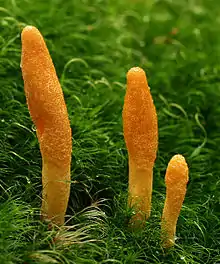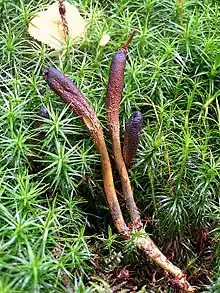Cordyceps
Cordyceps /ˈkɔːrdɪsɛps/ is a genus of ascomycete fungi (sac fungi) that includes about 600 species. Most Cordyceps species are endoparasitoids, parasitic mainly on insects and other arthropods (they are thus entomopathogenic fungi); a few are parasitic on other fungi.[2] The generic name Cordyceps is derived from the Greek word κορδύλη kordýlē, meaning "club", and the Greek word κεφαλή cephali, meaning "head".
| Cordyceps | |
|---|---|
 | |
| Cordyceps militaris | |
| Scientific classification | |
| Kingdom: | |
| Division: | |
| Class: | |
| Order: | |
| Family: | |
| Genus: | Cordyceps Fr. (1818) |
| Type species | |
| Cordyceps militaris (L.) Fr. (1818) | |
| Species[1] | |
| |
The genus has a worldwide distribution and most of the approximately 600 species[3] that have been described are from Asia (notably Nepal, China, Japan, Bhutan, Korea, Vietnam, and Thailand). Cordyceps species are particularly abundant and diverse in humid temperate and tropical forests.
Subtaxa
There are two recognized subgenera:[4]
Cordyceps subgen. Epichloe was at one time a subgenus, but is now regarded as a separate genus, Epichloë.[4]
C. sinensis was shown in 2007 by nuclear DNA sampling to be unrelated to most of the rest of the members of the genus; as a result it was renamed Ophiocordyceps sinensis and placed in a new family, the Ophiocordycipitaceae, as was "Cordyceps unilateralis".[7] Other species previously included in the genus Cordyceps have now been placed in the genus Tolypocladium.
Cordyceps and Metacordyceps spp. are now thought to be the teleomorphs of a number of anamorphic, entomopathogenic fungus "genera" such as: Beauveria (Cordyceps bassiana), Lecanicillium, Metarhizium and Nomuraea.
Biology
When a Cordyceps fungus attacks a host, the mycelium invades and eventually replaces the host tissue, while the elongated fruit body (ascocarp) may be cylindrical, branched, or of complex shape. The ascocarp bears many small, flask-shaped perithecia containing asci. These, in turn, contain thread-like ascospores, which usually break into fragments and are presumably infective.
Research
Polysaccharide components and cordycepin are under basic research and have been isolated from C. militaris.[8]
Sources and uses
Cordyceps are used in traditional Chinese medicine,[8][9] but there is no scientific evidence that their use has any clinical effect on human diseases.[8]
Gallery
 Cordyceps beginning its growth from a wasp
Cordyceps beginning its growth from a wasp Cordyceps militaris
Cordyceps militaris Cordyceps militaris
Cordyceps militaris
See also
References
- "Cordyceps". NCBI taxonomy. Bethesda, MD: National Center for Biotechnology Information. Retrieved 4 September 2019.
- Nikoh, N (April 2000). "Interkingdom host jumping underground: phylogenetic analysis of entomoparasitic fungus of the genus cordyceps". Mol Biol Evol. 17 (4): 629–38. doi:10.1093/oxfordjournals.molbev.a026341. PMID 10742053.
- Sung, Gi-Ho; Nigel L. Hywel-Jones; Jae-Mo Sung; J. Jennifer Luangsa-ard; Bhushan Shrestha & Joseph W. Spatafora (2007). "Phylogenetic classification of Cordyceps and the clavicipitaceous fungi". Stud Mycol. 57 (1): 5–59. doi:10.3114/sim.2007.57.01. PMC 2104736. PMID 18490993.
- "Cordyceps". Index Fungorum. Retrieved 4 September 2019.
- Elias Magnus Fries, Observ. mycol. (Havniae) 2: 316 (cancellans) (1818)
- Edmond Tulasne & Charles Tulasne, Select. fung. carpol. (Paris) 3: 20 (1865)
- Holliday, John; Cleaver, Matt (2008). "Medicinal Value of the Caterpillar Fungi Species of the Genus Cordyceps (Fr.) Link (Ascomycetes). A Review" (PDF). International Journal of Medicinal Mushrooms. New York: Begell House. 10 (3): 219–234. doi:10.1615/IntJMedMushr.v10.i3.30. ISSN 1521-9437. Archived from the original (PDF) on 2012-02-22. Retrieved 2009-03-10.
- "Cordyceps". Drugs.com. 14 September 2020. Retrieved 4 January 2021.
- Yue, K; Ye, M; Zhou, Z; Sun, W; Lin, X (April 2013). "The genus Cordyceps: a chemical and pharmacological review". The Journal of Pharmacy and Pharmacology. 65 (4): 474–93. doi:10.1111/j.2042-7158.2012.01601.x. PMID 23488776.
| Wikimedia Commons has media related to Cordyceps. |
| Wikispecies has information related to Cordyceps. |
